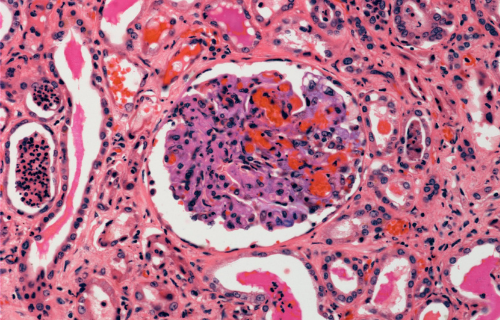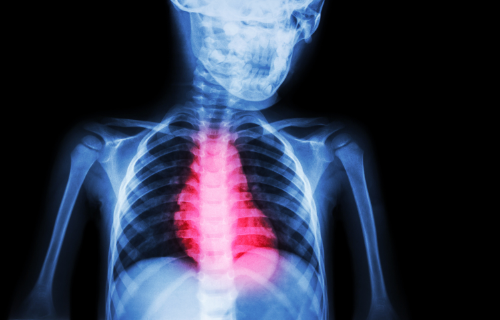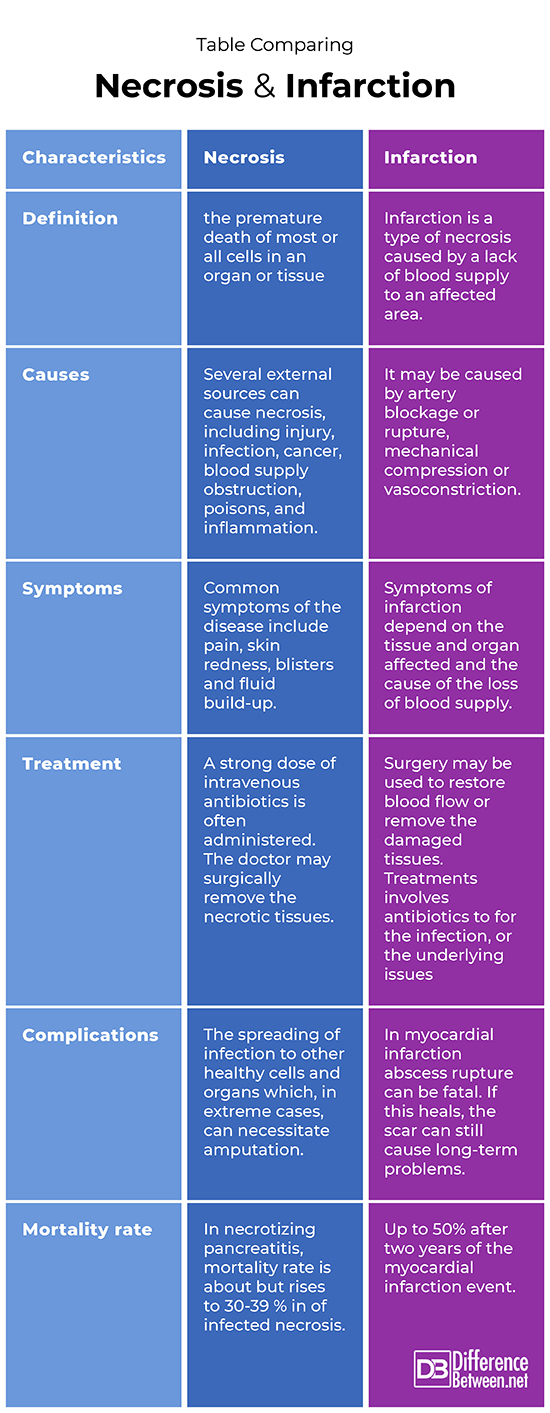Difference Between Necrosis and Infarction

What is Necrosis?
Necrosis is an unregulated and premature cell death. When this death results from blood flow blockage then this is referred to as infarction.
Definition
It is an uncontrolled premature cell death leading to swelling of the cell organelles, plasma membrane rupture and eventual lysis of the cell, and spillage of intracellular contents into the surrounding tissue leading to tissue damage.
Causes and risk factors:
Necrosis can be caused by external sources, including injury, infection, cancer, blood supply obstruction, poisons, and inflammation.
Diagnosis:
A physical exam is usually the first approach which will inform the need for subsequent tools such as blood tests, MRI or CT scans and a biopsy for pathology assessment.
Symptoms:
Common symptoms of necrosis include pain, redness of the skin, swelling, blisters, fluid collection, skin discoloration, sensation and numbness.
Complications:
The spreading of necrosis to other healthy cells and organs. One of the complications of necrosis is gangrene which, in extreme cases, can necessitate amputation. In necrotizing pancreatitis, complications can lead to sepsis shock and fatality
Treatment:
To treat necrosis, a strong dose of intravenous antibiotics is administered. At the next stage, the doctor will surgically remove the dead tissues.

What is infarction?
Definition:
Infarction is a type of necrosis or tissue death that is caused by a lack of blood supply to an affected area or cells.
Causes and risk factors:
It may be caused by artery blockage or rupture, mechanical compression or vasoconstriction.
Diagnosis:
Diagnosis of acute myocardial infarction is done by using a variety of techniques including measuring ECG changes, history, scintigraphy, echocardiography, and coronary angiogram.
Symptoms:
Typically, complete blood flow blockage is painful. Exact symptoms of infarction depend on the affected organ(s) or area.
For example, in acute myocardial infarction symptoms include ischemic symptoms, development of pathological Q waves changes in ECG and coronary artery intrusion.
Brain infarcts are usually minute and accompanied by transient ischemic attacks.
If the infarct affects the spinal cord, symptoms can be stroke-like with progressive loss of movement of lower extremities and sudden back pain.
Complications:
Complications from infarctions depend on the type of obstruction and the affected organ and tissue.
If sepsis sets in in the infarcts, saprobic bacteria may infect the infarct turning it into an abscess.
Abscess rupture can be fatal. Even when the abscess heals, the scarring may cause problems in the future.
Infarction in the brain can affect speech and function (including memory problems). In spinal cord infarctions, movement and sensation can be affected.
Treatment:
Treatment may include surgery to restore blood flow or to remove the damaged tissues, antibiotics to prevent or treat infection, or to treat underlying damage such as burns.
Difference between Necrosis and Infarction
Definition
Infarction is the process that results in an area of ischemic necrosis while necrosis is defined as any premature and unregulated cell or tissue death.
Causes
Infarction can be caused by obstructed blood supply due to arterial obstruction, venous blood flow obstruction and tissue hypoperfusion. Necrosis can be caused by infarction.
Symptoms
The symptoms of infarction depend on the tissue and organ affected and the reason for loss of blood supply arterial obstruction or venous blood flow obstruction. Symptoms typically include pain, skin redness, swelling, blisters, fluid accumulation and skin discoloration.
Treatment
Infarction treatment focuses on restoring blood flow and removing damaged tissue through surgery and antibiotics for the infections.
Necrosis treatment is focused on preventing the cell death of unaffected healthy cells and organs through surgery and broad-spectrum antibiotics.
Complications
Complications from infarctions depend on the type of obstruction and the affected organ and tissue.
In infarcts, sepsis can set in accompanied by bacterial infection, turning it into an abscess.
Necrosis complications can often lead to gangrene which may result in amputation of the affected limb.
Mortality rate
In necrotizing pancreatitis, mortality rate is about 15% but rises to 30-39% when necrosis gets infected.
Mortality rate after two years of initial myocardial infarctions can reach 50%.
Table comparing Necrosis and Infarction

FAQ:
What are the differences between ischemia and necrosis?
Ischemia results from insufficient oxygen to the tissue. Necrosis is the premature uncontrolled death of cells and tissue which can be caused by ischemia.
What is the difference between infarct and infarction?
An infarct is an area of ischemic necrosis. Infarction is the process that leads to this ischemic necrosis.
What is the difference between infarction and gangrene?
Blood flow obstruction in infarction is one of the processes leading to necrosis. Gangrene is one of the consequences of infarction. Gangrene is divided into dry and wet gangrene where it is either characterized by tissue mummification or moist and often infected by saprophytic bacteria, respectively.
What does necrosis mean?
Necrosis is the uncontrolled premature death of cells and tissue or organs.
- Difference Between Pericarditis and Costochondritis - April 8, 2022
- Difference Between Fibrinolysis and Thrombolytics - March 29, 2022
- Difference Between Necrosis and Infarction - March 18, 2022
Search DifferenceBetween.net :
Leave a Response
References :
[0]Adigun R, Basit H, Murray J. Necrosis, cell (liquefactive, coagulative, caseous, fat, fibrinoid, and gangrenous). StatPearls. 2020
[1]Khalid, Nabeeha, and Mahzad Azimpouran. Necrosis. StatPearls Publishing, 2021.
[2]Simon S. Cross, "Ischaemia, infarction and shock", Underwood's Pathology, Seventh edition, Elsevier, Philadelphia, 2019, pp 115-126
[3]Damjanov, I. “Hemodynamic Disorders.” Pathology Secrets, edited by I. Damjanov, Third ed., Mosby/Elsevier, Philadelphia, 2009, pp. 38–57.
[4]Neugebauer, H., et al. “Space-Occupying Cerebellar Infarction: Complications, Treatment, and Outcome.” Neurosurgeon Focus, vol. 34, no. 5, 2013, pp. 1–13.
[5]Bajaj, Anurag, et al. “Acute Complications of Myocardial Infarction in the Current Era: Diagnosis and Management.” Journal of Investigative Medicine, vol. 63, no. 7, 2015, pp. 844–55.
[6]Rashid, Mamoon Ur, et al. “Pancreatic Necrosis: Complications and Changing Trend of Treatment.” World Journal of Gastrointestinal Surgery, vol. 11, no. 4, 2019, pp. 198–217, doi:10.4240/wjgs.v11.i4.198.
[7]Saaby, Lotte, et al. "Mortality rate in type 2 myocardial infarction: observations from an unselected hospital cohort." The American journal of medicine, vol. 127, no. 4, 2014 pp. 295-302.
[8]Vaccarino, Viola, et al. "Sex-based differences in early mortality after myocardial infarction." New England Journal of Medicine, vol. 341, no. 4, 1999, pp. 217-225
[9]Jennifer Whitlock, RN. “Necrosis: What You Should Know.” Verywell Health, Verywell Health, 17 Nov. 2021, www.verywellhealth.com/what-is-necrotic-tissue-3157120.
[10]Bruyninckx, Rudi, et al. “Signs and Symptoms in Diagnosing Acute Myocardial Infarction and Acute Coronary Syndrome: A Diagnostic Meta-Analysis.” British Journal of General Practice, vol. 58, no. 547, 2008, pp. 105–11, doi:10.3399/bjgp08X277014.
